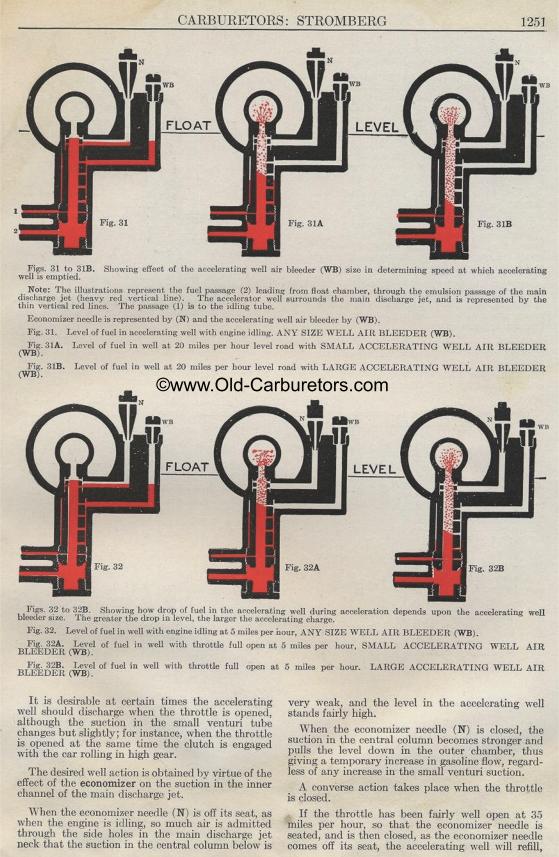CARBURETORS: STROMBERG
Figs. 31 to 31B. Showing effect of the accelerating well air
bleeder (WB) size in determining speed at which accelerating
well is emptied.
Note: The illustrations represent the fuel passage (2) leading
from float chamber, through the emulsion passage of the main
discharge jet (heavy red vertical line). The accelerator well
surrounds the main discharge jet, and is represented by the
thin vertical red lines. The passage (1) is to the idling tube.
Economizer needle is represented by (N) and the accelerating well
air bleeder by (WB).
Fig. 31. Level of fuel in accelerating well with engine idling.
ANY SIZE WELL AIR BLEEDER (WB).
Fig. 31A. Level of fuel in well at 20 miles per hour level road
with SMALL ACCELERATING WELL AIR BLEEDER (WB).
Fig. 31B. Level of fuel in well at 20 miles per hour level road
with LARGE ACCELERATING WELL AIR BLEEDER (WB).
Figs. 32 to 32B. Showing how drop of fuel in the accelerating well
during acceleration depends upon the accelerating well bleeder
size. The greater the drop in level, the larger the accelerating
charge.
Fig. 32. Level of fuel in well with engine idling at 5 miles per
hour, ANY SIZE WELL AIR BLEEDER (WB).
Fig. 32A. Level of fuel in well with throttle full open at 5 miles
per hour, SMALL ACCELERATING WELL AIR BLEEDER (WB).
Fig. 32B. Level of fuel in well with throttle full open at 5 miles
per hour. LARGE ACCELERATING WELL AIR BLEEDER (WB).
It is desirable at certain times the accelerating well should discharge
when the throttle is opened, although the suction in the small
venturi tube changes but slightly; for instance, when the throttle
is opened at the same time the clutch is engaged with the car rolling
in high gear.
The desired well action is obtained by virtue of the effect of
the economizer on the suction in the inner channel of the main
discharge jet.
When the economizer needle (N) is off its seat, as when the engine
is idling, so much air is admitted through the side holes in the
main discharge jet neck that the suction in the central column
below isvery weak, and the level in the accelerating well stands
fairly high.
When the economizer needle (N) is closed, the suction in the central
column becomes stronger and pulls the level down in the outer chamber,
thus giving a temporary increase in gasoline flow, regard-less
of any increase in the small venturi suction.
A converse action takes place when the throttle is closed.
If the throttle has been fairly well open at 35 miles per hour,
so that the economizer needle is seated, and is then closed, as
the economizer needle comes off its seat, the accelerating well
will refill,
Previous page 1927
Supplement Home Next page 
|
